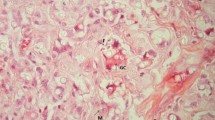Abstract
Background
Little is known about the immunological milieu of the skin-draining lymph nodes (LNs) in mycosis fungoides (MF).
Objectives
We studied dendritic cell (DC) subsets in the dermatopathic lymphadenitis of MF patients.
Methods
We immunohistochemically examined DC subsets and their distribution in 16 LN samples from 14 patients with MF (N1 LN, eight patients; N2, four; and N3, four), and we compared them with non-metastatic sentinel LNs from eight patients with melanoma.
Results
The number of S-100 protein+ DCs was markedly increased in the LNs from the MF patients and the major component was DC-LAMP+ mature DCs in the outer and paracortex areas, where DC-SIGN+ immature DCs were relatively decreased in proportion. In contrast, DC-SIGN+ cells were relatively increased in proportion compared to DC-LAMP+ cells in the medulla. Although no significant difference was observed in the proportions of CD1a+ or Langerin+ DCs among the N1, N2, and N3 nodes, CD163+ M2-type macrophages were increased in number in the N2 and N3 nodes.
Conclusions
Our observations indicate that mature DCs accumulate in the outer and paracortex areas in dermatopathic lymphadenitis and M2-type macrophages might increase in number during disease progression.






Similar content being viewed by others
References
Hwang ST, Janik JE, Jaffe ES, Wilson WH. Mycosis fungoides and Sézary syndrome. Lancet 2008; 371: 945–57.
Kim EJ, Hess S, Richardson SK, et al. Immunopathogenesis and therapy of cutaneous T cell lymphoma. J Clin Invest 2005; 115: 798–812.
Olsen E, Vonderheid E, Pimpinelli N, et al. Revisions to the staging and classification of mycosis fungoides and Sezary syndrome: a proposal of the International Society for Cutaneous Lymphomas (ISCL) and the cutaneous lymphoma task force of the European Organization of Research and Treatment of Cancer (EORTC). Blood 2007; 111: 1713–22.
Olsen EA, Whittaker S, Kim YH, et al. Clinical End Points and Response Criteria in Mycosis Fungoides and Sezary Syndrome: A Consensus Statement of the International Society for Cutaneous Lymphomas, the United States Cutaneous Lymphoma Consortium, and the Cutaneous Lymphoma Task Force of the European Organisation for Research and Treatment of Cancer. J Clin Oncol 2011; 29: 2598–607.
Schlapbach C, Ochsenbein A, Kaelin U, Hassan AS, Hunger RE, Yawalkar N. High numbers of DC-SIGN+ dendritic cells in lesional skin of cutaneous T-cell lymphoma. J Am Acad Dermatol. 2010; 62: 995–1004.
Der-Petrossian M, Valencak J, Jonak C, et al. Dermal infiltrates of cutaneous T-cell lymphomas with epidermotropism but not other cutaneous lymphomas are abundant with langerin+ dendritic cells. J Eur Acad Dermatol Venereol. 2011; 25: 922–7.
Burke JS, Colby TV. Dermatopathic lymphadenopathy. Comparison of cases associated and unassociated with mycosis fungoides. Am J Surg Pathol 1981; 5: 343–52.
Colby TV, Burke JS, Hoppe RT. Lymph node biopsy in mycosis fungoides. Cancer 1981; 47: 351–9.
Rausch E, Kaiserling E, Goos M. Langerhans cells and interdigitating reticulum cells in the thymus-dependent region in human dermatopathic lymphadenitis. Virchows Arch B Cell Pathol 1977; 25: 327–43.
Lampert IA, Pizzolo G, Thomas A, Janossy G. Immunohistochemical characterisation of cells involved in dermatopathic lymphadenopathy. J Pathol 1980; 131: 145–56.
Ladányi A, Kiss J, Somlai B, et al. Density of DC-LAMP(+) mature dendritic cells in combination with activated T lymphocytes infiltrating primary cutaneous melanoma is a strong independent prognostic factor. Cancer Immunol Immunother 2007; 56: 1459–69.
Elliott B, Scolyer RA, Suciu S, et al. Long-term protective effect of mature DC-LAMP+ dendritic cell accumulation in sentinel lymph nodes containing micrometastatic melanoma. Clin Cancer Res 2007; 13: 3825–30.
Matsuura K, Yamaguchi Y, Ueno H, Osaki A, Arihiro K, Toge T. Maturation of dendritic cells and T-cell responses in sentinel lymph nodes from patients with breast carcinoma. Cancer 2006; 106: 1227–36.
Author information
Authors and Affiliations
Corresponding author
About this article
Cite this article
Tada, K., Hamada, T., Asagoe, K. et al. Increase of DC-LAMP+ mature dendritic cell subsets in dermatopathic lymphadenitis of mycosis fungoides. Eur J Dermatol 24, 670–675 (2014). https://doi.org/10.1684/ejd.2014.2437
Accepted:
Published:
Issue Date:
DOI: https://doi.org/10.1684/ejd.2014.2437




